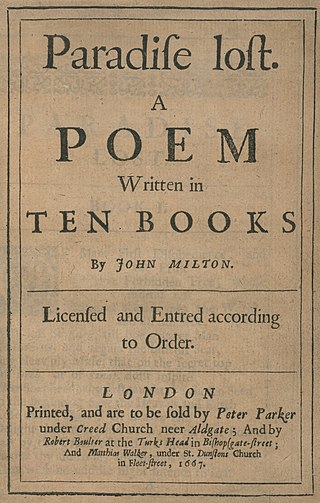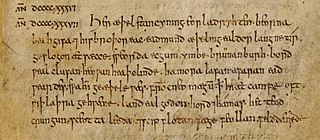Old English literature refers to poetry and prose written in Old English in early medieval England, from the 7th century to the decades after the Norman Conquest of 1066, a period often termed Anglo-Saxon England. The 7th-century work Cædmon's Hymn is often considered as the oldest surviving poem in English, as it appears in an 8th-century copy of Bede's text, the Ecclesiastical History of the English People. Poetry written in the mid 12th century represents some of the latest post-Norman examples of Old English. Adherence to the grammatical rules of Old English is largely inconsistent in 12th-century work, and by the 13th century the grammar and syntax of Old English had almost completely deteriorated, giving way to the much larger Middle English corpus of literature.

Paradise Lost is an epic poem in blank verse by the 17th-century English poet John Milton (1608–1674). The first version, published in 1667, consists of ten books with over ten thousand lines of verse. A second edition followed in 1674, arranged into twelve books with minor revisions throughout. It is considered to be Milton's masterpiece, and it helped solidify his reputation as one of the greatest English poets of all time. The poem concerns the biblical story of the fall of man: the temptation of Adam and Eve by the fallen angel Satan and their expulsion from the Garden of Eden.

Cædmon is the earliest English poet whose name is known. A Northumbrian cowherd who cared for the animals at the double monastery of Streonæshalch during the abbacy of St. Hilda, he was originally ignorant of "the art of song" but learned to compose one night in the course of a dream, according to the 8th-century historian Bede. He later became a zealous monk and an accomplished and inspirational Christian poet.
The Old English Bible translations are the partial translations of the Bible prepared in medieval England into the Old English language. The translations are from Latin texts, not the original languages.
Cynewulf is one of twelve Old English poets known by name, and one of four whose work is known to survive today. He presumably flourished in the 9th century, with possible dates extending into the late 8th and early 10th centuries.
The Old English poem Judith describes the beheading of Assyrian general Holofernes by Israelite Judith of Bethulia. It is found in the same manuscript as the heroic poem Beowulf, the Nowell Codex, dated ca. 975–1025. The Old English poem is one of many retellings of the Holofernes–Judith tale as it was found in the Book of Judith, still present in the Catholic and Orthodox Christian Bibles. The other extant version is by Ælfric of Eynsham, late 10th-century Anglo-Saxon abbot and writer; his version is a homily of the tale.
The Life of Adam and Eve, also known in its Greek version as the Apocalypse of Moses, is a Jewish apocryphal group of writings. It recounts the lives of Adam and Eve from after their expulsion from the Garden of Eden to their deaths. It provides more detail about the Fall of Man, including Eve's version of the story. Satan explains that he rebelled when God commanded him to bow down to Adam. After Adam dies, he and all his descendants are promised a resurrection.

The Junius manuscript is one of the four major codices of Old English literature. Written in the 10th century, it contains poetry dealing with Biblical subjects in Old English, the vernacular language of Anglo-Saxon England. Modern editors have determined that the manuscript is made of four poems, to which they have given the titles Genesis, Exodus, Daniel, and Christ and Satan. The identity of their author is unknown. For a long time, scholars believed them to be the work of Cædmon, accordingly calling the book the Cædmon manuscript. This theory has been discarded due to the significant differences between the poems.

The Heliand is an epic alliterative verse poem in Old Saxon, written in the first half of the 9th century. The title means "savior" in Old Saxon, and the poem is a Biblical paraphrase that recounts the life of Jesus in the alliterative verse style of a Germanic epic. Heliand is the largest known work of written Old Saxon.

Franciscus Junius, also known as François du Jon, was a pioneer of Germanic philology. As a collector of ancient manuscripts, he published the first modern editions of a number of important texts. In addition, he wrote the first comprehensive overview of ancient writings on the visual arts, which became a cornerstone of classical art theories throughout Europe.

Genesis A is an Old English poetic adaptation of the first half or so of the biblical book of Genesis. The poem is fused with a passage known today as Genesis B, translated and interpolated from the Old Saxon Genesis.
"Juliana", is one of the four signed Old English poems ascribed to the mysterious poet, Cynewulf, and is an account of the martyring of St. Juliana of Nicomedia. The one surviving manuscript, dated between 970 and 990, is preserved in the Exeter Book between the poems The Phoenix and The Wanderer. Juliana is one of only five Old English poetic texts that describe the lives of saints.

Christ and Satan is an anonymous Old English religious poem consisting of 729 lines of alliterative verse, contained in the Junius Manuscript.

Daniel is an anonymous Old English poem based loosely on the Biblical Book of Daniel, found in the Junius Manuscript. The author and the date of Daniel are unknown. Critics have argued that Cædmon is the author of the poem, but this theory has been since disproved. Daniel, as it is preserved, is 764 lines long. There have been numerous arguments that there was originally more to this poem than survives today. The majority of scholars, however, dismiss these arguments with the evidence that the text finishes at the bottom of a page, and that there is a simple point, which translators assume indicates the end of a complete sentence. Daniel contains a plethora of lines which Old English scholars refer to as “hypermetric” or long.

Exodus is the title given to an Old English alliterative poem in the 10th century Junius manuscript. Exodus is not a paraphrase of the biblical book, but rather a re-telling of the story of the Israelites' flight from Egyptian captivity and the Crossing of the Red Sea in the manner of a "heroic epic", much like Old English poems Andreas, Judith, or even Beowulf. It is one of the densest, most allusive and complex poems in Old English, and is the focus of much critical debate.

The Old English Hexateuch, or Aelfric Paraphrase, is the collaborative project of the late Anglo-Saxon period that translated the six books of the Hexateuch into Old English, presumably under the editorship of Abbot Ælfric of Eynsham. It is the first English vernacular translation of the first six books of the Old Testament, i.e. the five books of the Torah and Joshua. It was probably made for use by lay people.

Cædmon's Hymn is a short Old English poem attributed to Cædmon, a supposedly illiterate and unmusical cow-herder who was, according to the Northumbrian monk Bede, miraculously empowered to sing in honour of God the Creator. The poem is Cædmon's only known composition.

The "Battle of Brunanburh" is an Old English poem. It is preserved in the Anglo-Saxon Chronicle, a historical record of events in Anglo-Saxon England which was kept from the late ninth to the mid-twelfth century. The poem records the Battle of Brunanburh, a battle fought in 937 between an English army and a combined army of Scots, Vikings, and Britons. The battle resulted in an English victory, celebrated by the poem in style and language like that of traditional Old English battle poetry. The poem is notable because of those traditional elements and has been praised for its authentic tone, but it is also remarkable for its fiercely nationalistic tone, which documents the development of a unified England ruled by the House of Wessex.
Hatton Gospels is the name now given to a manuscript produced in the late 12th century or early 13th century. It contains a translation of the four gospels into the West Saxon dialect of Old English. It is a nearly complete gospel book, missing only a small part of the Gospel of Luke. It is now in the Bodleian Library, Oxford, as MS Hatton 38. The fullest description of the manuscript is by Takako Kato, in Treharne, et al., eds., Production and Use of English Manuscripts, 1020-1220.
Genesis is an Old Saxon Biblical poem recounting the story of the Book of Genesis, dating to the first half of the 9th century, three fragments of which are preserved in a manuscript in the Vatican Library, Palatinus Latinus 1447. It and the Heliand, a heroic poem based on the New Testament, a fragment of which is also included in the same manuscript, constitute the only major records of Old Saxon poetry. It is also the basis of the Anglo-Saxon poem known as Genesis B, and Eduard Sievers postulated its existence on linguistic evidence before the manuscript was discovered.













